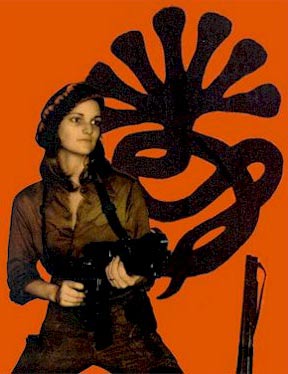My paper for the EAAS conference in Oslo last week dealt with icons and icon work, continuing a line of research I began about 5 years ago when I participated in a conference in Austria with the theme of US Icons. The convener of both the AAAS event in 2003 and of the Oslo workshop was Klaus Rieser of Graz, Austria whose tireless work is beginning to make an emergent interdisciplinary field out of Icon Studies.
It is the elderly Manson who fuels the imagination of icon workers that use him in a politicized discourse, as witnessed first by a right wing manipulation of Manson’s image, photo-shopped into a photo of former Democrat candidate for President, John Kerry, who was the victim of a vicious slander campaign due to his past as an anti-Vietnam War activist. Here a grinning Manson in a suit modelled on Kerry’s (as is Manson’s hair style) shows the Senator a piece of paper or a photograph (perhaps a snapshot of the original Manson victims), and they appear to share a moment of confidence, although Kerry’s closed eyes might indicate that the image Manson shows him is a bit too much to take in. Note the Swastika on Manson’s forehead (he had used a knife to scrawl an 'X' on his forehead during his trial, and this 'X' later turned into a Swastika in popular legend), as well as the Kerry campaign button on his lapel.
In a parallel image, this time used to satirize Kerry’s defeater, George W. Bush, Manson’s photograph (the raw image is the same, and here the hair and attire are not airbrushed or photo-shopped) is used for a different type of collaborative icon work, this time more oppositional in nature. It is accompanied by an amusing text calling for the approval by the Senate of Manson as ambassador to the Klingon Empire (referencing the Star Trek universe). In this narrative Manson works for the Republicans as (crudely) indicated by the replacement of the Swastika on his forehead, which is substituted with a GOP Elephant, the symbol of the Republican Party. Bush and Condoleeza Rice are both ‘quoted’ as supporting Manson’s speedy appointment, saying for instance that “questions about Manson’s management style shouldn’t be part of the confirmation process”.
These two instances will be perceived as collaborative only from a politically partisan view. Both authors use Manson’s monstrosity to satirize the party he or she does not belong to. They are both hegemonically inscribed in a party political system, although not officially sanctioned by either party. The main iconic image I have selected for analysis is however a true homage to Manson.
Here Manson is a saint and a martyr, signalled as in classical religious iconography via a representation of his stigmata. Here we note again the Swastika on Manson’s forehead, echoed in even more stylized form in his halo along with pentagrams that associate Manson with Satanism. His other stigmata consist of the blood stains on his face and neck and the strange umbilical chord of blood stretching from the back of his skull into the background of the icon. The photograph used as template for the icon is one depicting Manson in a particularly wild-eyed moment, taken shortly after his arrest, but prior to the X’ing incident. The choice of red, black and purple colours for Manson’s halo and the background (the traditional rays of light signalling the subject’s holiness in religious icons is here turned negative and black) contrast sharply with his pale skin. Taken together with the Swastika this composition and colour scheme serve to underscore Manson’s racial programme which the creator of the icon obviously condones. On the website I originally located the image there is a click through link to a further shrine for Satanism and Alistair Crowley which opens when Manson’s image is clicked.
Manson’s afterlife as an icon is thus prolonged by oppositional, collaborative icon work, falling within at least three spheres (which are not as separate as they perhaps should be): political, religious and pop-culture discourses all feed off his image...
Turning now to Patty Hearst, we encounter a story much intertwined in the same counterculture background as the Manson legend. Heiress Hearst was the victim of an extremely high profile kidnapping in 1974, at the tail end of the armed struggle that militant splinter groups originating in the counter-culture and its anti-capitalist agenda was waging in America. The kidnappers, the bizarrely named Symbionese Liberation Army, carried out urban guerrilla warfare inspired by South American left-wing groups. Their agenda further included an attempt to free African-American inmates from the US prison system which their rhetoric compared to concentration camps and apartheid regime oppression a la South Africa. The SLA saw itself as spearheading a Black revolution in America and took as its symbol a seven-headed cobra snake – each head representing a Kwanzaa principle, such as unity, creativity and faith. After kidnapping Hearst and demanding various types of ransom payment (in kind, to be distributed among the poor), Hearst apparently willingly switched sides and joined the SLA in a bank robbery, generating one of the more iconic images of Patty (now known as Tania) wielding a sub-machine gun.
The SLA was eventually hunted down by the police and in an extremely violent shoot-out which resulted in a fire, most of the SLA members were killed. Hearst and a few SLA members escaped the siege and shootout, but were arrested soon after. During the trial, Hearst again switched persona and claimed that her participation in the robbery was coerced and that she had been sexually abused and brainwashed during her captivity by the SLA. She was sentenced to a fairly mild stretch in jail, her sentence was reduced by President Carter and eventually she was fully pardoned by President Clinton. A number of iconic cultural texts have been generated by this sequence of events.
The best known icon of Hearst is the image of her in front of the SLA cobra on a bright orange background. ‘Tania’ stares aggressively at ‘the Man’, ready to fire her Thompson gun – another weapon is ready in the background. This is revolutionary iconography 101, down to the army fatigues, the beret, the weapon and the surprising amount of cleavage shown. The phallic cobra offers a potent reminder of Tania’s taming, but also boosts her new-found revolutionary clout. As an ironic paean to this image Warren Zevon has put Patty Hearst into the lyrics of his tall-tale of mercenaries, post-colonial African liberation wars, upright, well-meaning Norwegian boys displaying bravery, sinister Danish power brokers, and CIA engineered betrayal followed by posthumous just deserts in the form of a headless ghost’s revenge: “Roland, the Headless Thompson Gunner”. The song ends on a didactic note:
The eternal Thompson gunner
Still wand'ring through the night
Now it's ten years later, but he still keeps up the fight
In Ireland, in Lebanon, in Palestine and Berkeley
Patty Hearst heard the burst
Of Roland's Thompson gun and bought it…
What exactly the meaning of the closing phrase “and bought it” means is an interesting point of debate. To buy something, of course means to acquire it for money, but also to buy into a story hook, line and sinker. The court case against Hearst revolved exactly around this point: did she buy the rhetoric of the SLA, or was she coerced or seduced, becoming a case of Stockholm Syndrome? My take on Zevon, who has many songs about masculine exploits gone horribly wrong (“Send lawyers, guns and money – the shit has hit the fan” is a line that springs to mind), is that he is warning us all against being taken in by revolutionary bravado and romanticism. To him Hearst is the naïve, protected, socialite teen who temporarily falls for the seduction of revolutionary ardour (a sentiment I would guess many of us can recognize).Here is Zevon performing his song on Letterman:
More images of Hearst and Manson available here...
Read the rest of my paper in due course when it appears in print or as part of my book on Icons of Transgression...






